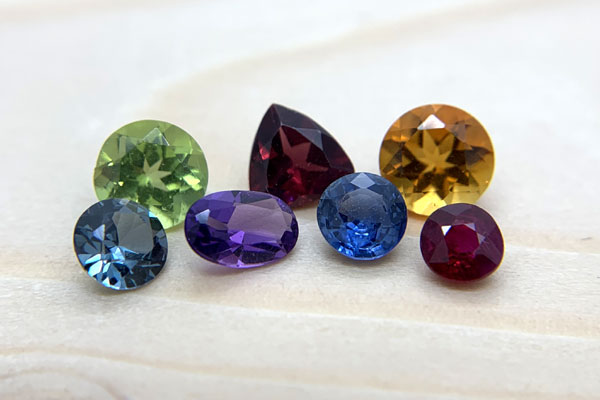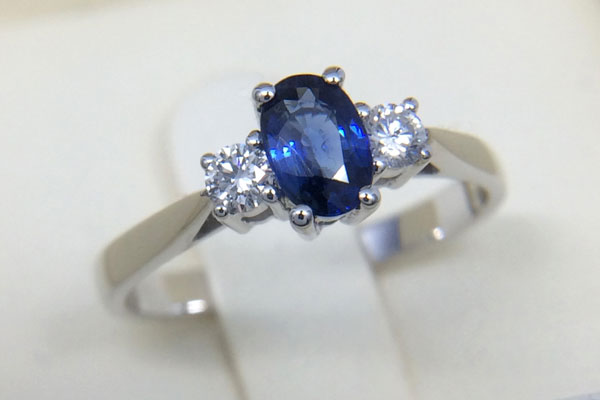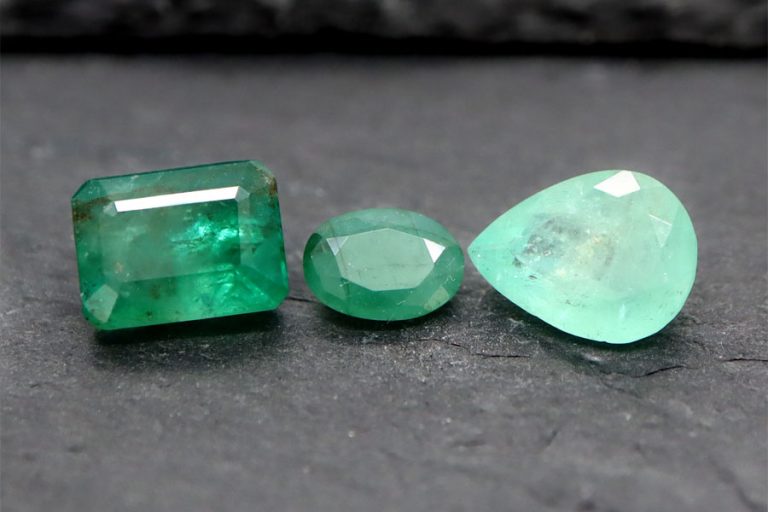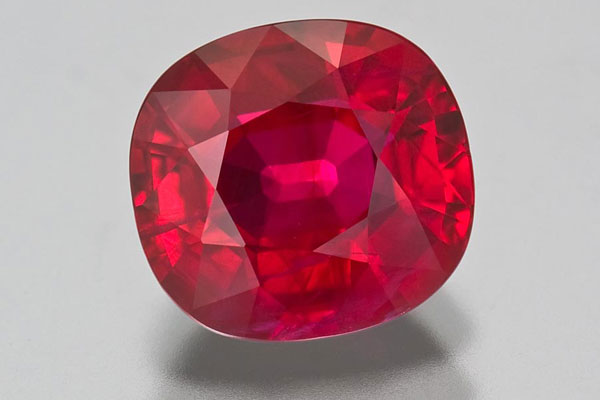Sapphire Gemstone Guide – Price, Quality Factors & More!
If you clicked on this post, then I’m guessing you want to learn more about Sapphires?
Awesome, you have come to the right place as my Sapphire Gem Guide takes you through what you need to know about these amazing stones, whether you are looking to buy one or just looking to learn, so let’s get started…
Quick Sapphire Facts:

Sapphire Properties and Origins
I’m not going to get too scientific here but the properties of Sapphire are one of the reasons why it is such an amazing gemstone (and one of my favourites!).
As I said in the facts section above, Sapphire is part of the Corundum family of gemstones, which also includes Ruby and Corundum is Aluminium Oxide (AI2O3), which in its purest form is colourless and the colours found in Sapphire are caused by chemical impurities, for example:
- Blue is caused by the presence of Iron and Titanium
- Yellow is caused by trace elements of Iron
- Pink is caused by small amounts of Chromium (which also causes red in Ruby)
Let’s stop with the chemistry lesson and look at the physical properties of Sapphire as they are very durable gemstones and a great alternative to Diamond for engagement rings as they have the following properties:

Hardness
Sapphires have a hardness of 9 on the Mohs Hardness scale.

Toughness
Sapphires have very good toughness.

Stability
Sapphires are very stable.
If you aren’t sure what I mean by these terms, I’ve covered them below:
- Hardness – this how hard the surface of the gemstones is
- Toughness – this is how strong the stone is in terms of the stone breaking or fracturing
- Stability – which is how well the stone deals with physical and chemical changes such as heat, light and exposure to chemicals (things like cleaning products etc)
Where Are Sapphires Found?
Sapphires are found in many countries around the world, with important locations being Sri Lanka, Madagascar, Australia, the US (Montana) and Thailand.
When it comes to the origin of Sapphires, some locations are more desirable than others and the country of origin will be used to describe and sell the stone, these desirable locations include:
- Kashmir – even though Sapphires haven’t been commercially mined in Kashmir for over 100 years, it is by far the most desirable and expensive origin for Sapphires and many still believe that the best quality Blue Sapphires came from Kashmir
- Myanmar (Burma) – while known for producing the best Rubies, Myanmar as it is now known is also a very important location for high-quality Blue Sapphires, with many believing that the best examples are second only to Kashmir
- Sri Lanka – a very important location for Sapphires of all colours but especially Blue and Padparadscha, they are also one of the largest producers of Sapphire. Sri Lankan Sapphires are commonly referred to as Ceylon Sapphires and the country has produced some of the largest Blue Sapphires ever found
Some locations are more well-known for certain types of Sapphires, such as Australia and Montana for Parti-Sapphires (which show more than one colour), even though they produce Sapphires of different colours.
Thailand is an interesting one as not only have Sapphires been mined there for over 100 years but they are also the leading cutting and trading centre for Sapphires and many of the world’s Sapphires will probably have passed through there at some point.
Sapphire Price
Sapphire prices can vary massively from less than $20/carat to over $100,000/carat due to the large number of factors that affect the price of a Sapphire, including:
This makes pricing Sapphires quite challenging, which is why this is done on a stone-by-stone basis by people who understand the Sapphire market and makes it nearly impossible to give any kind of guide to Sapphire prices online.
In the Sapphire Quality Factors section below, I will look at some of these sections in much more detail and explain how these factors impact the price of Sapphires.
Sapphire Quality & Price Factors
Now we know what Sapphires are and where they come from, let’s take a look at the quality and price factors as these all play an important role in how much a Sapphire is worth!
Sapphire Colour
Arguably the most important quality factor for Sapphires is the colour and when talking about colour, there are two different things to consider, which are:
The Different Colours of Sapphire

Yes but when most people think of Sapphire, they probably picture a beautiful blue gem but Sapphires can be found in pretty much any colour you can think of, including Green, Yellow, Purple, Orange and Pink amongst many others.
When it comes to value, some colours are more valuable than others due to the demand and availability of that colour in the market and generally:
This mainly applies to Western markets but in some markets, Green and Yellow Sapphires are much more in demand than Pink or Purple stones.
Quality of the Colour
The second part is the quality of the colour as this has a big impact on the value of a Sapphire and applies to all body colours.
Very good quality Sapphires have a rich, vibrant body colour with good hues and saturation that is spread evenly across the stone, with lower quality stones either being very light or dark or having an uneven distribution of colour across the stone.

The image above demonstrates this perfectly as:
- The stone on the left is very dark and appears black when looking down through the top of the stone, it also has an opaque appearance (no light passing through the stone)
- The middle stone has good clarity and transparency but the stone is a pale blue colour, it is a much better quality stone than the one the left but still not the most desirable.
- The final stone is a fine gem quality Sapphire, it has good clarity and transparency but also possesses a very desirable deep, rich blue colour.
One thing that can be quite commonly found in Sapphires is angular colour zoning as can be seen in one of my rings.
Colour zoning is bands of colour that range from blue to colourless in Blue Sapphires, these are visible in the stone and may only be visible from certain angles, depending on how they have been cut.
These are not as desirable as Sapphires that have an even colour distribution but it is an indication that the stone is natural and it does add character.

Sapphire Clarity
Up there with colour in terms of importance is clarity and this is how free from inclusions and blemishes the stone is and in the chart below, you can see the difference between the two:
Good Clarity
Poor Clarity
Not all inclusions are bad in a Sapphire though and some can be used to identify the origin of the stone and also whether or not it has been treated.
While the majority of the time, most people will be looking for an ‘eye clean’, transparent Sapphire, there is one exception to the rule!
And that is Star Sapphires, which are heavily included, opaque Sapphires that show a phenomenon known as asterism, which you can clearly see in the GIA picture.
The Asterism is caused by lots of rutile needles within the stone that follow the growth structure of the natural crystal and when the stone is cut properly, the light reflects off these inclusions to cause the appearance of the star.
These are highly desirable among collectors.

Sapphires Are NOT Clarity Graded
Unlike Diamonds, Sapphires are not clarity graded by gemmologists or gem labs, so be aware of anyone selling a Sapphire who is using Diamond clarity grades such as SI or VVS to describe the clarity of a Sapphire.
Sapphire Cut
The next quality factor is cut and just like colour, this is broken down into two parts, which are the style of the cut and the quality of cut.
Style of Cut
The majority of natural Sapphires on the market are usually cut in one of four styles, which are:
- Oval
- Cushion (including elongated cushions)
- Round
- Emerald or Hexagonal




This is because these styles not only help bring out the stunning colour found in Sapphires but also produce the best yield from the rough crystal from which they are cut.
But Sapphires can also be cut into Marquise and Heart shapes but the demand for the styles of cut are quite a bit lower than the four popular cut styles.
Quality of Cut
Not all Sapphires are cut to the same quality, this usually isn’t an issue with more expensive Sapphires as the cutter takes more time to make sure the stone is cut and polished to a high standard as the stone will be worth more as a result.
But this can be an issue with lower-quality Sapphires and can result in:
- Poor proportions such as the crown or pavilion being too deep or shallow
- Facets not being aligned properly
- Table being off-centre
- Wonky girdle

This can make the gem not look as good as it could if it had been cut properly and it also makes setting the stone into a piece of jewellery more challenging for the setter.
Sapphire Treatments
Sapphires with good colour and clarity are rare in nature and there is nowhere near enough of these stones to satisfy the demand for them.
This is why the majority (over 90%) of Sapphires for sale at any one time have been treated in one way or another and there are a number of different ways that Sapphires can be treated and they all have an impact on the value of the stone, the most common of these treatments are:
Heat Treatment
This is an industry-accepted treatment as it replicates what happens in nature and the results of the treatment are permanent.
The goal of Heat treatment depends on the stone but can be used to:
• Make stones lighter or darker
• Alter the colour slightly
• Remove undesirable hues or colour zoning
• Improve clarity
Heat + Flux
A modification of the traditional heat treatment is to add flux to the process (usually borax) as the flux can help to partially heal surface-reaching fractures, which makes them less noticeable.
As with heat treatment, the results are permanent but it should be disclosed.
Diffusion
A treatment that is becoming more common is diffusion, this is where they heat the Sapphire to a very high temperature in the presence of either Titanium or Beryllium to alter the colour of the stone.
The resulting colour is permanent but may not penetrate deep into the stone, especially with Titanium diffusion and this should always be disclosed.
Glass Filling
Glass-filling is done to very low-quality material with the goal being to fill and reduce the appearance of fractures within the stone.
This is done by heating the stone in the presence of lead-glass powder, which melts and fills the fractures.
While it makes stones look better, the treatment isn’t permanent and can easily be removed and should always be disclosed.
And when it comes to price, if and how the Sapphire has been treated does have a big impact, which is why disclosure is so important but it is assumed that all Sapphires have been heat-treated, which is why this is rarely disclosed.
But for all other treatments, they should be disclosed and as for prices, the following list should be helpful:
This is where lab reports can be very useful as reputable labs will test the stone for treatments (Beryllium diffusion requires advanced equipment) and they will report their findings as to if the Sapphire has been treated or not and what they treatment was.

Natural vs Synthetic (Lab-Grown) Sapphires

A very important thing you want to know when buying a Sapphire is whether the stone is natural or synthetic as the price difference between a natural and synthetic of similar qualities can be hugely different!
For example, the synthetic Sapphire in the image above can be bought for less than $10/carat but a natural of the same size and quality would easily be over $1000/carat and could be over $10,000/carat if it hasn’t been treated.
If the stone is being sold as a Sapphire, then it is assumed that the stone is natural as all synthetic stones state that is synthetic, man-made or lab-created so that you as the buyer know that it isn’t a natural Sapphire.
Lab Reports
Lab Reports are an important document but not every Sapphire will be sold with a report as unlike Diamond reports, they don’t give any information about the quality of the stone but they do include some very useful information, which can include:
- The stone, size, weight etc
- The identity of the stone
- Whether the stone is natural or synthetic
- If the stone has been treated or not
- The origin of the stone (it is not possible to do this on some stones)
And a report from a reputable gem lab, such as the GIA, Gubelin, SSEF, IGI or Anchorcert is essential if the seller is claiming that the Sapphire is untreated and from a specific location.
Just a quick note, the labs mentioned above only produce reports, they never produce certificates. If you ever see a Sapphire with documentation that says certificate or certificate of authenticity then run away as fast as you can!!
Sapphire Gemstone FAQ
Conclusion
I know that this is a bit of a long guide but I wanted to provide you with as much information as possible so that you can buy the perfect Sapphire for yourself or the person you plan on giving it to.
And by educating yourself around Sapphires, you can make a more informed buying decision that will hopefully result in you getting the perfect stone and not overpaying for it.
Other articles from The Gem Guide series:
I'm Paul Haywood FGA DGA, the owner and founder of Haywoods Gems, I'm a fully qualified Gemmologist and Diamond Grader from the Gemmological Association of Great Britain.










